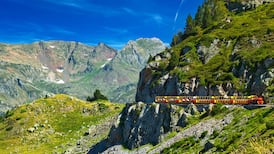If “a place apart” can survive in a globalised world the sequestered Glencolumbkille truly ticks the right boxes. Startlingly green while surrounded by contrasting sombre mountains, it is easy to see why St Columkille chose it for a monastic site – contemplation is writ large on its weather-worn face.
Despite this saintly intervention, Glencolumbkille remained remote and poverty-stricken until the 20th century, when it was revitalised by a Donegal priest, Fr James McDyer, who championed rural rights and created abundant local employment. Today it is a bustling tourism honeypot.
My descent into St Columkille’s glen is breath-robbingly beautiful, with the emerald-hued valley laid out in isolation below. Setting out from the local fire station by following blue arrows, it becomes immediately obvious that this isn’t just any old ramble.
Tagging an ancient pilgrim path, rich with megalithic tombs, standing stones and cairns, I reach Columkille’s Chapel at Beefan. I soon diverge from the pilgrims heading for Columkille’s Well and begin ascending a switchback track to reach a Napoleonic signal tower. Constructed in a time when a small man with a big hat threatened these islands, the tower serves today as a locus for views over the harshly beautiful but treacherous Donegal coastline.
Retracing my steps, I follow the arrows for the Tower Loop before breaking right to cross the boggy but benign summits of Beefan and Garveross mountains, then descend to an upland path beside a large communications mast. Here, an old mass path, which once linked the now deserted village of Port to Glencolumbkille, falls away left.
As I descend, an expansive prospect unfolds over a pretty harbour and beyond to the poignant ruins of the forsaken village, which was reputedly abandoned to escape Famine hunger.
Port seems a place where the 21st century still remains in the hazy future. Sitting by the harbour as fishermen tend their nets, it is hard to imagine it in any other mood. Yet it must have seemed cruel and terrifying to the 19 sailors who perished here in 1870, when the barque Sydney was driven by fierce storms onto this unforgiving coastline.
Dragging myself away, I retrace my steps uphill to the communications mast, where a service roadway leads south with a glorious vista over Glencolumbkille. The arrows for the Tower Loop then convey me through a gate before meandering downhill to a cross-inscribed pillar. According to local traditional, a hole cut through it allows those without sin to glimpse heaven.
Fearing to interrogate my state of sanctity, I pass on this and continue by following the arrows to the floor of the glen. Soon, I regain my start point and then top-of with delicious chowder in the nearby restaurant of the Oideas Gael cultural centre.
Map: Discovery Sheet 10.
Terrain: Rough underfoot conditions demand sturdy footwear, while being well kitted out is required to cope with high, exposed, uplands. In mist, navigational skills are required on Beefan and Garveross mountains.
Getting there: From Donegal town follow the N56 west to Killybegs and then take the R263 to Glencolumbkille. The trailhead is nearby the firestation.
Distance: About 14km.
Time: 4 hours.










